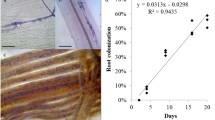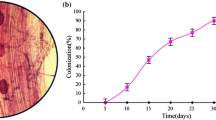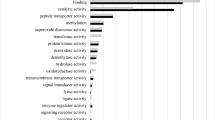Abstract
Arbuscular mycorrhiza (AM) formed between plant roots and fungi is one of the most widespread symbiotic associations in nature. To understand the molecular mechanisms of AM formation, we profiled 30 symbiosis-related genes expressed in Amorpha fruticosa roots colonized by Glomus mosseae and in non-mycorrhizal roots at different stages using differential-display RT-PCR (DDRT-PCR). The expressed genes were confirmed by reverse Northern blotting. Eleven fragments were sequenced and putatively identified by homologous alignment. Of the eleven AM-related genes, five were obtained at the early-stage of plant-fungus interaction and six at the later stage. Three expressed sequence tag (ESTs) sequences were found to originate from the fungi and eight from the host plant by use of PCR evaluation of gDNA of both plant and fungi. The target genes included an ATP-binding cassette sub-family transporter gene, a transposon-insertion display band, and a photosynthesis-related gene. The results provided information on the molecular mechanisms underlying the development of mycorrhizal symbiosis between woody plants and AM fungi.
Similar content being viewed by others
References
Akiyama K, Matsuzaki K, Hayashi H. 2005. Plant sesquiterpenes induce hyphal branching in arbuscular mycorrhizal fungi. Nature, 435(7043): 824–827.
Antunes PM, Rajcan I, Goss MJ. 2006b. Specific flavonoids as interconnecting signals in the tripartite symbiosis formed by arbuscular mycorrhizal fungi, Bradyrhizobium japonicum (Kirchner) Jordan and soybean (Glycine max (L.) Merr.). Soil Biology & Biochemistry, 38: 533–543.
Antunes PM, Varennes A, Rajcan I, Goss MJ. 2006a. Accumulation of specific flavonoids in soybean (Glycine max (L.) Merr.) As a function of the early tripartite symbiosis with arbuscular mycorrhizal fungi and Bradyrhizobium japonicum (Kirchner) Jordan. Soil Biology & Biochemistry, 38: 1234–1242.
Barbour MM, Hanson DT. 2009. Stable carbon isotopes reveal dynamics of respiratory metabolism. New Phytol, 181(2):243–245.
Bauer D, Muuller H, Reich J, Ahrenkiel V, Warthoe P, Strauss M. 1993. Identification of differentially expressed mRNA species by an improved display technique (DDRT-PCR). Nucleic Acids Research, 21(18): 4272–4280.
Besserer A, Puech-Pagès V, Kiefer P, Gomez-Roldan V, Jauneau A, Roy S, Portais JC, Roux C, Bécard G, Séjalon-Delmas N. 2006. Strigolactones stimulate arbuscular mycorrhizal fungi by activating mitochondria. PLoS Biol, 4(7): 2–6.
Bonfante P, Genre A. 2008. Plants and arbuscular mycorrhizal fungi: an evolutionary-developmental perspective. Trends Plant Sci, 13(9): 492–498.
Bonfante P., Genre A. 2010. Mechanisms underlying beneficial plant fungus interactions in mycorrhizal symbiosis. Nat Commun, 1: 48.
Bozkurt O, Unver T, Akkaya MS. 2007. Genes associated with resistance to wheat yellow rust disease identified by differential display analysis. Physiological and Molecular Plant Pathology, 71(4-6): 251–259.
Brechenmacher L, Weidmann S, van Tuinen D. 2004. Expression profiling of up-regulated plant and fungal genes in early and late stages of Medicago truncatula-Glomus mosseae interactions. Mycorrhiza, 14(4): 253–262.
Breuninger M, Requena N. 2004. Recognition events in AM symbiosis: analysis of fungal gene expression at the early appressorium stage. Fungal Genetics and Biology, 41(8): 794–804.
Brewer PB, Elizabeth AD, Ferguson BJ. 2009. Strigolactone acts downstream of auxin to regulate bud outgrowth in pea and arabidopsis. Plant Physiol, 150(1): 482–493.
Brundrett MC. 2002. Coevolution of roots and mycorrhizas of land plants. New Phytologist, 154(2): 275–304.
Bucher M, Wegmüller S, Drissner D. 2009. Chasing the structures of small molecules in arbuscular mycorrhizal signaling. Curr Opin Plant Biol, 12(4): 500–507.
Chen C, Fan C, Zhu H. 2009a. Antiquity and function of CASTOR and POLLUX, the twin ion channel-encoding genes key to the evolution of root symbioses in plants. Plant Physiol, 149(1): 306–317.
Chen CY, Huang DJ and Liu JQ. 2009b. Functions and toxicity of nickel in plants: recent advances and future prospects. Clean, 37(4-5): 304–313.
Corradi N, Sanders IR. 2006. Evolution of the P-type II ATPase gene family in the fungi and presence of structural genomic changes among isolates of Glomus intraradices. BMC Evol Biol, 6: 21–22.
Dumbrell AJ, Nelson M, Helgason T, Dytham C. 2010. A.H. Fitter Idiosyncrasy and overdominance in the structure of natural communities of arbuscular mycorrhizal fungi: is there a role for stochastic processes. J Ecol, 98: 419–428.
Evelin H, Kapoor R, mGiri B. 2009. Arbuscular mycorrhizal fungi in alleviation of salt stress: a review. Annals of botany, 104(7): 1263–1280.
Fabi JP, Lajolo FM, do Nascimento JRO. 2009. Cloning and characterization of transcripts differentially expressed in the pulp of ripening papaya. Scientia Horticulturae, 121(2): 159–165.
Fitter A.H, Helgason T. 2011. A. Hodge Nutritional exchanges in the arbuscular mycorrhizal symbiosis: implications for sustainable agriculture. Fungal Biol Rev, 25: 68–72.
Gomez SK, Javot H, Deewatthanawong P. 2009. Medicago truncatula and Glomus intraradices gene expression in cortical cells harboring arbuscules in the arbuscular mycorrhizal symbiosis. BMC Plant Biol, 9: 10–11.
Grunwald U, Nyamsuren O, Tamasloukht M. 2004. Identification of mycorrhiza-regulated genes with arbuscule development-related expression profile. Plant Mol Biol, 55(4):553–66.
Guether M, Balestrini R, Hannah M. 2008. Genome-wide reprogramming of regulatory networks, transport, cell wall and membrane biogenesis during arbuscular mycorrhizal symbiosis in Lotus japonicus. New Phytologist, 182(1): 200–212.
Halary S., Malik S.B., Lildhar L., Slamovits C.H. 2011. Conserved meiotic machinery in Glomus spp., a putatively ancient asexual fungal lineage. Genome Biol Evol, 3: 950–958.
Harrison MJ. 1998. Development of the arbuscular mycorrhizal symbiosis. Plant Biology, 1: 360–365.
Hausmann NT, Hawkes CV. 2009. Plant neighborhood control of arbuscular mycorrhizal community composition. New Phytol, 183(4): 1188–1200.
Helber N, Requena N. 2008. Expression of the fluorescence markers DsRed and GFP fused to a nuclear localization signal in the arbuscular mycorrhizal fungus Glomus intraradices. New Phytol, 177: 537–548.
Hua J, Lin X, Yin R. 2009. Effects of arbuscular mycorrhizal fungi inoculation on arsenic accumulation by tobacco (Nicotiana tabacum L.). J Environ Sci, 21(9): 1214–1220.
Karandashov V, Nagy R, Wegmuller S. 2004. Evolutionary conservation of a phosphate transporter in the arbuscular mycorrhizal symbiosis. Proc Natl Acad Sci USA, 101(16): 6285–6290.
Kaschuk G, Leffelaar PA, Giller KE, Alberton O. 2010. Responses of legumes to rhizobia and arbuscular mycorrhizal fungi: A meta-analysis of potential photosynthate limitation of symbioses. Soil biology & biochemistry, 42: 125–127.
Kistner C, Winzer T, Pitzschke A, Mulder L. 2005. Seven Lotus japonicus Genes Required for Transcriptional Reprogramming of the Root during Fungal and Bacterial Symbiosis. Plant Cell, 17(8): 2217–2229.
Koch AM, Croll D, Sanders LR. 2006. Genetic variability in a population of arbuscular mycorrhizal fungi causes variation in plant growth. Ecol Lett, 9(2): 103–110.
Kosuta S, Chabaud M, Dénarié J. 2003. A diffusible factor from arbuscular mycorrhizal fungi induces symbiosis-specific MtENOD11 expression in roots of Medicago truncatula. Plant Physiol, 131(3): 952–962.
Krüger C.M., Krüger, Walker, Stockinger. 2012. A. Schüßler Phylogenetic reference data for systematics and phylotaxonomy of arbuscular mycorrhizal fungi from phylum to species level. New Phytol, 193: 970–984.
Küster H, Vieweg MF, Manthey K. 2007. Identification and expression regulation of symbiotically activated legume genes. Phytochemistry, 68(1): 8–18.
Lee J, Young JP. 2010. The mitochondrial genome sequence of the arbuscular mycorrhizal fungus Glomus intraradices isolate 494 and implications for the phylogenetic placement of Glomus. New Phytol, 183: 200–211.
Liu J, Blaylock LA, Endre G. 2003. Transcript profiling coupled with spatial expression analyses reveals genes involved in distinct developmental stages of an arbuscular mycorrhizal symbiosis. Plant Cell, 15(90): 2106–2123.
Liu YJ, Zhang AN, Jia JF and Li A. 2007. Cloning of salt stress responsive cDNA from wheat and resistant analysis of differential fragment SR07 in transgenic tobacco. J Genet Genomics, 34(9): 842–849.
Malloch DW, Pirozynski KA, Raven PH. 1980. Ecological and evolutionary significance of mycorrhizal symbioses in vascular plants. Ecology, 77: 2113–2118.
Martin F, Gianinazzi-Pearson V. 2008. The long hard road to a completed Glomus intraradices genome. New Phytol, 180:747–750.
Miransari M, Bahrami HA, Rejali F. 2009. Effects of arbuscular mycorrhiza, soil sterilization, and soil compaction on wheat (Triticum aestivum L.) nutrients uptake. Soil & Tillage Research, 104(1): 48–55.
Mortimer PE, Perez-Fernandea MA, Hannahalentine AJ. 2009. Arbuscular mycorrhizae affect the N and C economy of nodulated Phaseolus vulgaris (L.) during NH4+ nutrition. Soil Biology & Biochemistry, 41(10): 2115–2121.
Msiska Z, Morton JB. 2009. Isolation and sequence analysis of a-tubulin gene from arbuscular mycorrhizal fungi. Mycorrhiza, 19(7): 501–513.
Nadimi M, Beaudet D, Forget L. 2012. Group I intron-mediated trans-splicing in mitochondria of Gigaspora rosea and a robust phylogenetic affiliation of arbuscular mycorrhizal fungi with Mortierellales. Mol Biol Evol http://dx.doi.org/10.1093/molbev/mss088.
Nadimi M, Beaudet D, Forget L. 2012. Lang Group I intron-mediated trans-splicing in mitochondria of Gigaspora rosea and a robust phylogenetic affiliation of arbuscular mycorrhizal fungi with Mortierellales. Mol Biol Evol: http://dx.doi.org/10.1093/molbev/mss088.
Nagy R, Drissner D, Amrhein N. 2009. Mycorrhizal phosphate uptake pathway in tomato is phosphorus-repressible and transcriptionally regulated. New Phytol. 181(4): 950–959.
Ohtomo R, Saito M. 2005. Polyphosphate dynamics in mycorrhizal roots during colonization of an arbuscular mycorrhizal fungus. New Phytol, 167(2): 571–578.
Olsson PA, Hansson MC, Burleigh SH. 2006. Effect of P availability on temporal dynamics of carbon allocation and Glomus intraradices high-affinity P transporter gene induction in arbuscular mycorrhiza. Appl Environ Microbiol, 72(6): 4115–4120.
Pandit SS, Kulkarni RS, Giri AP. 2010. Expression profiling of various genes during the fruit development and ripening of mango. Plant Physiol Biochem, 48(6): 426–433.
Parniske M. 2004. Molecular genetics of the arbuscular mycorrhizal symbiosis. Curr Opin Plant Biol, 7(4):414–421.
Paszkowsk U. 2006. A journey through signaling in arbuscular mycorrhizal symbioses. New Phytol, 172(1): 35–46.
Paungfoo-Lonhienne C, Lonhienne TG. 2008. Plants can use protein as a nitrogen source without assistance from other organisms. Proc Natl Acad Sci USA, 105(11): 4524–4529.
Pitet M, Camprubí A, Calvet C, Estaún V. 2009. A modified staining technique for arbuscular mycorrhiza compatible with molecular probes. Mycorrhiza, 19(2): 125–131.
Ponce MA, Bompadre MJ, Scervino JM. 2009. Flavonoids, benzoic acids and cinnamic acids isolated from shoots and roots of Italian rye grass (Lolium multiflorum Lam.) with and without endophyte association and arbuscular mycorrhizal fungus. Biochemical Systematics and Ecology, 37: 245–253.
Rameau C. 2010. Strigolactones, a novel class of plant hormone controlling shoot branching. Comptes Rendus Biologies, 333(4): 344–349.
Rasmussen S, Parsons AJ, Fraser K. 2008. Metabolic profiles of Lolium perenne are differentially affected by nitrogen supply, carbohydrate content, and fungal endophyte infection. Plant Physiol, 146(3): 1440–1453.
Reinhardt D. 2007. Programming good relations-development of the arbuscular mycorrhizal symbiosis. Curr Opin Plant Biol, 10(1): 98–105.
Saito K, Yoshikawa M, Yano K. 2007. NUCLEOPORIN85 is required for calcium spiking, fungal and bacterial symbioses, and seed production in Lotus japonicus. Plant Cell, 19(2): 610–624.
Sambrook J, Fritsch EF, Maniatis T. 1989. Molecular Cloning: A laboratory manual, 2nd edn. New York: Cold Spring Harbor Laboratory, p. 659.
Sanders IR, Croll D. 2010. Arbuscular mycorrhiza: the challenge to understand the genetics of the fungal partner. Annu Rev Genet, 44:271–292.
Scervino JM, Ponce MA, Erra-Bassells R. 2005. Flavonoids exhibit fungal species and genus specific effects on the presymbiotic growth of Gigaspora and Glomus. Mycol Res, 109(7): 789–794.
Schenkluhn L, Hohnjec N, Niehaus K. 2010. Differential gel electrophoresis (DIGE) to quantitatively monitor early symbiosis- and pathogenesis-induced changes of the Medicago truncatula root proteome. J Proteomics, 73(4):753–768.
Schüßler A, Schwarzott D, Walker C. 2010. A new fungal phylum. The Glomeromycota: phylogeny and evolution. Mycol Res, 105: 1413–1421.
Sedzielewska KA, Fuchs J, Temsch EM. 2011. Estimation of the Glomus intraradices nuclear DNA content. New Phytol, 192: 794–797.
Smith S.E. 2011. Smith Roles of arbuscular mycorrhizas in plant nutrition and growth: new paradigms from cellular to ecosystem scales. Annu Rev Plant Biol, 62: 227–250.
Smith SE, Barker SJ, Zhu YG. 2006. Fast moves in arbuscular mycorrhizal symbiotic signalling. Trends Plant Sci, 11(8): 369–371.
Tisserant E, Kohler A, Dozolme-Seddas P.2012. The transcriptome of the arbuscular mycorrhizal fungus Glomus intraradices (DAOM 197198) reveals functional tradeoffs in an obligate symbiont. New Phytol, 193: 755–769.
Trouvelot A, Kough JL, Gianinazzi-Pearson V. 1986. Mesure dutaux de mycorhization VA d’un systme radiculaire ayant une signification fonctionnelle. In: Gianinazzi-Pearson V, Giani-nazzi S (eds), Les mycorhizes, physiologie et genetique, INRA, Paris: 217–221.
Uibopuu A, Moora M, Saks U. 2009. Differential effect of arbuscular mycorrhizal fungal communities from ecosystems along management gradient on the growth of forest understory plant species. Soil Biology & Biochemistry, 41: 2141–2146.
Vallino M, Greppi D, Novero M. 2009. Rice root colonisation by mycorrhizal and endophytic fungi in aerobic soil. Ann Appl Biol, 154(2): 195–204.
Wehner J, Antunes PM, Powell JR. 2010. Plant pathogen protection by arbuscular mycorrhizas: A role for fungal diversity? Pedobiologia, 53: 197–201.
Wu QS, Xia RX, Zou YN. 2006. Reactive oxygen metabolism in mycorrhizal and non-mycorrhizal citrus (Poncirus trifoliata) seedlings subjected to water stress. J Plant Physiol, 163(11): 1101–1110.
Yoneyama K, Xie X, Sekimoto H. 2008. Strigolactones, host recognition signals for root parasitic plants and arbuscular mycorrhizal fungi, from Fabaceae plants. New Phytol, 179(2): 484–494.
Yoshida S, Maruyama S, Nozaki H. 2010. Horizontal gene transfer by the parasitic plant Striga hermonthica. Science, 328:1128.
Author information
Authors and Affiliations
Corresponding author
Additional information
Project funding: This study was supported by National Natural Science Foundation of China (31070576 and 31270535), Natural Science Foundation of Heilongjiang Province of China (No.ZD201206), Excellent Youth Foundation of Heilongjiang Province of China (No.JC201306) and High-level Talents Support Program of Heilongjiang University (Ecological Restoration Team).
Rights and permissions
About this article
Cite this article
Song, F., Li, J. & Zhang, X. Characterization of expressed genes in the establishment of arbuscular mycorrhiza between Amorpha fruticosa and Glomus mosseae . Journal of Forestry Research 25, 541–548 (2014). https://doi.org/10.1007/s11676-014-0493-7
Received:
Accepted:
Published:
Issue Date:
DOI: https://doi.org/10.1007/s11676-014-0493-7




